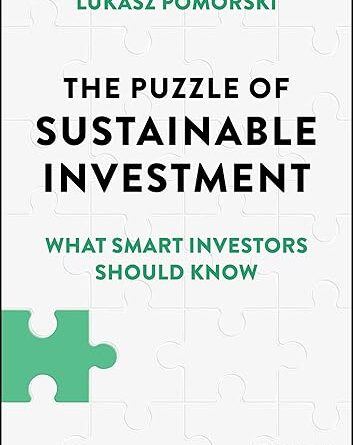
The Puzzle of Sustainable Investment: What Smart Investors Should Know. 2024. Lukasz Pomorski. Wiley.
In The Puzzle of Sustainable Investment, Lukasz Pomorski, senior vice president at Acadian Asset Management and an adjunct professor at Columbia University, presents a collection of important tools for the sustainable investor to navigate the fiercely contested subject of environmental, social, and governance (ESG) investing. He analyzes the channels through which sustainability shapes corporate decisions and discusses many practical examples and case studies that provide a succinct summary of the industry’s key issues. Pomorski adeptly discusses the good, the bad, and the unknown of sustainable investing while acknowledging that the answer to some of the critical questions is the dreaded “it depends.”
Based on a simple thought experiment, Pomorski correctly concludes that ESG characteristics are a source of information and some of this information may be helpful in pursuing financial goals irrespective of how investors feel about ESG investing more broadly. Therefore, by a simple leap of logic, the ESG-aware portfolio will exhibit a higher Sharpe ratio than the ESG-unaware portfolio. ESG integration (incorporating ESG considerations into one’s views of risk and return) is a good thing since it may help investors build better portfolios.
Since ESG investors also build constraints into their investment process, however, it may lead to the formation of a “sin premium” or relatively higher expected returns from holding securities with poor ESG scores, such as tobacco or fossil fuel companies. These higher returns are not a compensation for risk or for poorer quality of future cash flows but, rather, a direct consequence of investors’ tastes and preferences. Pomorski displays an ESG-efficient frontier of a carbon-aware portfolio that shows reducing carbon to 30% of benchmark emissions reduces financial attractiveness by close to 5% and a reduction to 10% of benchmark emissions costs about 15%. This chart exposes the risk–return trade-off in reducing carbon intensity and financial attractiveness in a portfolio.
Pomorski references a new paper[1] that analyzed thousands of stocks traded in 48 different countries and assessed ESG ratings from seven different providers. Based on the principles of market efficiency, he supports the report’s conclusion that there is very little evidence that ESG ratings are related to global stock returns. Later in the book, he discusses how any outperformance will likely need to arise from investing in companies that exhibit improvement in financially material ESG factors. Pomorski supports the claim, however, that ESG ratings may provide insights about the risk of the underlying companies. For example, a portfolio tilted toward stocks with strong ESG ratings will hold relatively safer stocks than those in an otherwise similar portfolio instead tilted toward poor ESG ratings.
Three case studies, involving Engine No. 1 and ExxonMobil, green bonds, and building net-zero portfolios, are discussed to illustrate positive impact through investment portfolios. As a real estate finance practitioner, I found the green bond case study to be most insightful. Since ESG-motivated investors are willing to pay a premium for labeled bonds (green bonds), this “greenium” means that investors are willing to provide the company with cheaper capital, provided that the use of proceeds is for green projects. Green bonds have impact through the financing cost channel, whereas in the ExxonMobil example, the impact comes through the control channel.
Finally, Pomorski explores how shorting and commodity futures can be used as part of the toolkit in an investor’s ESG integration process.
In summary, The Puzzle of Sustainable Investment is a thoughtful and practical book with rigorous research backing much of Pomorski’s conclusions. Since Milton Friedman articulated his shareholder-primacy theory in 1970, we have observed an evolution of how we think about the role of business and the corporation in American society. Although global sustainable flows turned negative for the first time on record in the fourth quarter of 2023, the most pessimistic assessments of sustainable assets indicate that at least $3 trillion is currently invested in sustainable strategies.
[1]R. Alves, P. Krueger, and M. A. van Dijk, “Drawing Up the Bill: Is ESG Related to Stock Returns around the World?,” working paper, University of Geneva (2023).






